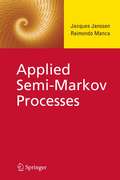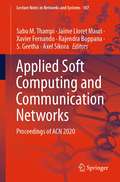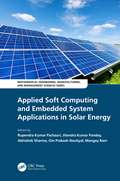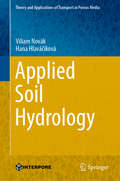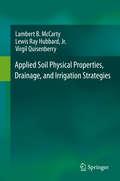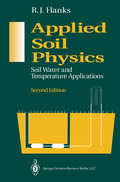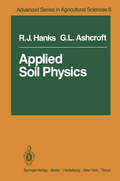- Table View
- List View
Applied Second Law Analysis of Heat Engine Cycles
by S. Can GülenApplied Second Law Analysis of Heat Engine Cycles offers a concise, practical approach to one of the two building blocks of classical thermodynamics and demonstrates how it can be a powerful tool in the analysis of heat engine cycles. Including real system models with the industry-standard heat balance simulation software, the Thermoflow Suite (GTPRO/MASTER, PEACE, THERMOFLEX) and Excel VBA, the book discusses both the performance and the cost. It also features both calculated and actual examples for gas turbines, steam turbines, and simple and combined cycles from major original equipment manufacturers (OEMs). In addition, novel cycles proposed by researchers and independent technology developers will also be critically examined. This book will be a valuable reference for practicing engineers, enabling the reader to approach the most difficult thermal design and analysis problems in a logical manner.
Applied Second Law Analysis of Heat Engine Cycles
by S. Can GülenApplied Second Law Analysis of Heat Engine Cycles offers a concise, practical approach to one of the two building blocks of classical thermodynamics and demonstrates how it can be a powerful tool in the analysis of heat engine cycles. Including real system models with the industry-standard heat balance simulation software, the Thermoflow Suite (GTPRO/MASTER, PEACE, THERMOFLEX) and Excel VBA, the book discusses both the performance and the cost. It also features both calculated and actual examples for gas turbines, steam turbines, and simple and combined cycles from major original equipment manufacturers (OEMs). In addition, novel cycles proposed by researchers and independent technology developers will also be critically examined. This book will be a valuable reference for practicing engineers, enabling the reader to approach the most difficult thermal design and analysis problems in a logical manner.
Applied Semi-Markov Processes
by Jacques Janssen Raimondo MancaAims to give to the reader the tools necessary to apply semi-Markov processes in real-life problems. The book is self-contained and, starting from a low level of probability concepts, gradually brings the reader to a deep knowledge of semi-Markov processes. Presents homogeneous and non-homogeneous semi-Markov processes, as well as Markov and semi-Markov rewards processes. The concepts are fundamental for many applications, but they are not as thoroughly presented in other books on the subject as they are here.
Applied Sensory Analy of Foods
by Howard R. MoskowitzThis book extends the analysis of perception of food qualities to the area of multivariate methods. It presents the field of sensory analysis and gives the reader first-hand descriptions of research approaches and applications.
Applied Sensory Analy of Foods
by Howard R. MoskowitzThis book extends the analysis of perception of food qualities to the area of multivariate methods. It presents the field of sensory analysis and gives the reader first-hand descriptions of research approaches and applications.
Applied Signal Processing: A MATLAB™-Based Proof of Concept
by Thierry Dutoit Ferran MarquesApplied Signal Processing: A MATLAB-Based Proof of Concept benefits readers by including the teaching background of experts in various applied signal processing fields and presenting them in a project-oriented framework. Unlike many other MATLAB-based textbooks which only use MATLAB to illustrate theoretical aspects, this book provides fully commented MATLAB code for working proofs-of-concept. The MATLAB code provided on the accompanying online files is the very heart of the material. In addition each chapter offers a functional introduction to the theory required to understand the code as well as a formatted presentation of the contents and outputs of the MATLAB code.Each chapter exposes how digital signal processing is applied for solving a real engineering problem used in a consumer product. The chapters are organized with a description of the problem in its applicative context and a functional review of the theory related to its solution appearing first. Equations are only used for a precise description of the problem and its final solutions. Then a step-by-step MATLAB-based proof of concept, with full code, graphs, and comments follows. The solutions are simple enough for readers with general signal processing background to understand and they use state-of-the-art signal processing principles. Applied Signal Processing: A MATLAB-Based Proof of Concept is an ideal companion for most signal processing course books. It can be used for preparing student labs and projects.
Applied Signal Processing: Concepts, Circuits, and Systems
by Nadder HamdyClassical signal processing techniques are based primarily on the analog nature of all signals. However, the continuously improving performance of digital circuitry and processors has prompted a switch to digital signal processing techniques rather than the traditional analog ones. Applied Signal Processing recognizes the linkage between
Applied Simulation and Optimization: In Logistics, Industrial and Aeronautical Practice
by Miguel Mujica Mota Idalia Flores De La Mota Daniel Guimarans SerranoPresenting techniques, case-studies and methodologies that combine the use of simulation approaches with optimization techniques for facing problems in manufacturing, logistics, or aeronautical problems, this book provides solutions to common industrial problems in several fields, which range from manufacturing to aviation problems, where the common denominator is the combination of simulation’s flexibility with optimization techniques’ robustness.Providing readers with a comprehensive guide to tackle similar issues in industrial environments, this text explores novel ways to face industrial problems through hybrid approaches (simulation-optimization) that benefit from the advantages of both paradigms, in order to give solutions to important problems in service industry, production processes, or supply chains, such as scheduling, routing problems and resource allocations, among others.
Applied Simulation and Optimization 2: New Applications in Logistics, Industrial and Aeronautical Practice
by Miguel Mujica Mota Idalia Flores De La MotaBuilding on the author’s earlier Applied Simulation and Optimization, this book presents novel methods for solving problems in industry, based on hybrid simulation-optimization approaches that combine the advantages of both paradigms. The book serves as a comprehensive guide to tackling scheduling, routing problems, resource allocations and other issues in industrial environments, the service industry, production processes, or supply chains and aviation. Logistics, manufacturing and operational problems can either be modelled using optimization techniques or approaches based on simulation methodologies. Optimization techniques have the advantage of performing efficiently when the problems are properly defined, but they are often developed through rigid representations that do not include or accurately represent the stochasticity inherent in real systems. Furthermore, important information is lost during the abstraction process to fit each problem into the optimization technique. On the other hand, simulation approaches possess high description levels, but the optimization is generally performed through sampling of all the possible configurations of the system. The methods explored in this book are of use to researchers and practising engineers in fields ranging from supply chains to the aviation industry.
Applied Smart Health Care Informatics: A Computational Intelligence Perspective (The Wiley Series in Intelligent Signal and Data Processing)
by Sourav DeApplied Smart Health Care Informatics Explores how intelligent systems offer new opportunities for optimizing the acquisition, storage, retrieval, and use of information in healthcare Applied Smart Health Care Informatics explores how health information technology and intelligent systems can be integrated and deployed to enhance healthcare management. Edited and authored by leading experts in the field, this timely volume introduces modern approaches for managing existing data in the healthcare sector by utilizing artificial intelligence (AI), meta-heuristic algorithms, deep learning, the Internet of Things (IoT), and other smart technologies. Detailed chapters review advances in areas including machine learning, computer vision, and soft computing techniques, and discuss various applications of healthcare management systems such as medical imaging, electronic medical records (EMR), and drug development assistance. Throughout the text, the authors propose new research directions and highlight the smart technologies that are central to establishing proactive health management, supporting enhanced coordination of care, and improving the overall quality of healthcare services. Provides an overview of different deep learning applications for intelligent healthcare informatics management Describes novel methodologies and emerging trends in artificial intelligence and computational intelligence and their relevance to health information engineering and management Proposes IoT solutions that disseminate essential medical information for intelligent healthcare management Discusses mobile-based healthcare management, content-based image retrieval, and computer-aided diagnosis using machine and deep learning techniques Examines the use of exploratory data analysis in intelligent healthcare informatics systems Applied Smart Health Care Informatics: A Computational Intelligence Perspective is an invaluable text for graduate students, postdoctoral researchers, academic lecturers, and industry professionals working in the area of healthcare and intelligent soft computing.
Applied Smart Health Care Informatics: A Computational Intelligence Perspective (The Wiley Series in Intelligent Signal and Data Processing)
by Sourav De Rik Das Siddhartha Bhattacharyya Ujjwal MaulikApplied Smart Health Care Informatics Explores how intelligent systems offer new opportunities for optimizing the acquisition, storage, retrieval, and use of information in healthcare Applied Smart Health Care Informatics explores how health information technology and intelligent systems can be integrated and deployed to enhance healthcare management. Edited and authored by leading experts in the field, this timely volume introduces modern approaches for managing existing data in the healthcare sector by utilizing artificial intelligence (AI), meta-heuristic algorithms, deep learning, the Internet of Things (IoT), and other smart technologies. Detailed chapters review advances in areas including machine learning, computer vision, and soft computing techniques, and discuss various applications of healthcare management systems such as medical imaging, electronic medical records (EMR), and drug development assistance. Throughout the text, the authors propose new research directions and highlight the smart technologies that are central to establishing proactive health management, supporting enhanced coordination of care, and improving the overall quality of healthcare services. Provides an overview of different deep learning applications for intelligent healthcare informatics management Describes novel methodologies and emerging trends in artificial intelligence and computational intelligence and their relevance to health information engineering and management Proposes IoT solutions that disseminate essential medical information for intelligent healthcare management Discusses mobile-based healthcare management, content-based image retrieval, and computer-aided diagnosis using machine and deep learning techniques Examines the use of exploratory data analysis in intelligent healthcare informatics systems Applied Smart Health Care Informatics: A Computational Intelligence Perspective is an invaluable text for graduate students, postdoctoral researchers, academic lecturers, and industry professionals working in the area of healthcare and intelligent soft computing.
Applied Soft Computing and Communication Networks: Proceedings of ACN 2023 (Lecture Notes in Networks and Systems #966)
by Jimson Mathew Sabu M. Thampi Jiankun Hu Ashok Kumar Das Shikha TripathiThis book constitutes thoroughly refereed post-conference proceedings of the International Applied Soft Computing and Communication Networks (ACN 2023) held at PES University, Bangalore, India, during December 18–20, 2023. The research papers presented were carefully reviewed and selected from several initial submissions. The papers are organized in topical sections on security and privacy, network management and software-defined networks, Internet of Things (IoT) and cyber-physical systems, intelligent distributed systems, mobile computing and vehicle communications, and emerging topics. The book is directed to the researchers and scientists engaged in various fields of intelligent systems.
Applied Soft Computing and Communication Networks: Proceedings of ACN 2020 (Lecture Notes in Networks and Systems #187)
by Sabu M. Thampi Jaime Lloret Mauri Xavier Fernando Rajendra Boppana S. Geetha Axel SikoraThis book constitutes thoroughly refereed post-conference proceedings of the International Applied Soft Computing and Communication Networks (ACN 2020) held in VIT, Chennai, India, during October 14–17, 2020. The research papers presented were carefully reviewed and selected from several initial submissions. The book is directed to the researchers and scientists engaged in various fields of intelligent systems.
Applied Soft Computing and Communication Networks: Proceedings of ACN 2019 (Lecture Notes in Networks and Systems #125)
by Sabu M. Thampi Elizabeth Sherly Soura Dasgupta Jaime Lloret Mauri Jemal H. Abawajy Evgeny Khorov Jimson MathewThis book constitutes best selected research papers presented at the International Applied Soft Computing and Communication Networks (ACN 2019) held in Trivandrum, Kerala, India during December 18 – 21, 2019. The papers are organized in topical sections on real time and multimedia communications, security and privacy, network management and software-defined networks, Internet of Things (IoT) and cyber-physical systems, intelligent distributed systems, mobile computing and vehicle communications, surveillance networks and visual intelligence, and emerging topics. The book is a reference for researchers and scientists engaged in various fields of intelligent systems.
Applied Soft Computing and Embedded System Applications in Solar Energy (Mathematical Engineering, Manufacturing, and Management Sciences)
by Rupendra Kumar Pachauri Jitendra Kumar Pandey Abhishek Sharma Om Prakash Nautiyal Mangey RamApplied Soft Computing and Embedded System Applications in Solar Energy deals with energy systems and soft computing methods from a wide range of approaches and application perspectives. The authors examine how embedded system applications can deal with the smart monitoring and controlling of stand-alone and grid-connected solar photovoltaic (PV) systems for increased efficiency. Growth in the area of artificial intelligence with embedded system applications has led to a new era in computing, impacting almost all fields of science and engineering. Soft computing methods implemented to energy-related problems regularly face data-driven issues such as problems of optimization, classification, clustering, or prediction. The authors offer real-time implementation of soft computing and embedded system in the area of solar energy to address the issues with microgrid and smart grid projects (both renewable and non-renewable generations), energy management, and power regulation. They also discuss and examine alternative solutions for energy capacity assessment, energy efficiency systems design, as well as other specific smart grid energy system applications. The book is intended for students, professionals, and researchers in electrical and computer engineering fields, working on renewable energy resources, microgrids, and smart grid projects. Examines the integration of hardware with stand-alone PV panels and real-time monitoring of factors affecting the efficiency of the PV panels Offers real-time implementation of soft computing and embedded system in the area of solar energy Discusses how soft computing plays a huge role in the prediction of efficiency of stand-alone and grid-connected solar PV systems Discusses how embedded system applications with smart monitoring can control and enhance the efficiency of stand-alone and grid-connected solar PV systems Explores swarm intelligence techniques for solar PV parameter estimation Dr. Rupendra Kumar Pachauri is Assistant Professor – Selection Grade in the Department of Electrical and Electronics Engineering, University of Petroleum and Energy Studies (UPES), Dehradun, India. Dr. Jitendra Kumar Pandey is Professor & Head of R&D in the University of Petroleum and Energy Studies (UPES), Dehradun, India. Mr. Abhishek Sharma is working as a research scientist in the research and development department (UPES, India). Dr. Om Prakash Nautiyal is working as a scientist in Uttarakhand Science Education & Research Centre (USERC), Department of Information and Science Technology, Govt. of Uttarakhand, Dehradun, India. Prof. Mangey Ram is working as a Research Professor at Graphic Era Deemed to be University, Dehradun, India.
Applied Soft Computing and Embedded System Applications in Solar Energy (Mathematical Engineering, Manufacturing, and Management Sciences)
by Mangey Ram Rupendra Kumar Pachauri Jitendra Kumar Pandey Abhishek Sharmu Om Prakash NautiyalApplied Soft Computing and Embedded System Applications in Solar Energy deals with energy systems and soft computing methods from a wide range of approaches and application perspectives. The authors examine how embedded system applications can deal with the smart monitoring and controlling of stand-alone and grid-connected solar photovoltaic (PV) systems for increased efficiency. Growth in the area of artificial intelligence with embedded system applications has led to a new era in computing, impacting almost all fields of science and engineering. Soft computing methods implemented to energy-related problems regularly face data-driven issues such as problems of optimization, classification, clustering, or prediction. The authors offer real-time implementation of soft computing and embedded system in the area of solar energy to address the issues with microgrid and smart grid projects (both renewable and non-renewable generations), energy management, and power regulation. They also discuss and examine alternative solutions for energy capacity assessment, energy efficiency systems design, as well as other specific smart grid energy system applications. The book is intended for students, professionals, and researchers in electrical and computer engineering fields, working on renewable energy resources, microgrids, and smart grid projects. Examines the integration of hardware with stand-alone PV panels and real-time monitoring of factors affecting the efficiency of the PV panels Offers real-time implementation of soft computing and embedded system in the area of solar energy Discusses how soft computing plays a huge role in the prediction of efficiency of stand-alone and grid-connected solar PV systems Discusses how embedded system applications with smart monitoring can control and enhance the efficiency of stand-alone and grid-connected solar PV systems Explores swarm intelligence techniques for solar PV parameter estimation Dr. Rupendra Kumar Pachauri is Assistant Professor – Selection Grade in the Department of Electrical and Electronics Engineering, University of Petroleum and Energy Studies (UPES), Dehradun, India. Dr. Jitendra Kumar Pandey is Professor & Head of R&D in the University of Petroleum and Energy Studies (UPES), Dehradun, India. Mr. Abhishek Sharma is working as a research scientist in the research and development department (UPES, India). Dr. Om Prakash Nautiyal is working as a scientist in Uttarakhand Science Education & Research Centre (USERC), Department of Information and Science Technology, Govt. of Uttarakhand, Dehradun, India. Prof. Mangey Ram is working as a Research Professor at Graphic Era Deemed to be University, Dehradun, India.
Applied Soft Computing Technologies: The Challenge of Complexity (Advances in Intelligent and Soft Computing #34)
by Mario Köppen Bertram Nickolay Ajith Abraham Bernard De BaetsThis volume presents the proceedings of the 9th Online World Conference on Soft Computing in Industrial Applications, held on the World Wide Web in 2004. It includes lectures, original papers and tutorials presented during the conference. The book brings together outstanding research and developments in soft computing, including evolutionary computation, fuzzy logic, neural networks, and their fusion, and its applications in science and technology.
Applied Soil Hydrology (Theory and Applications of Transport in Porous Media #32)
by Viliam Novák Hana HlaváčikováThis state-of-the-art book clearly explains the basic principles of soil hydrology and the current knowledge in this field. It particularly highlights the estimation and application of measurements and evaluation of soil-hydrophysical characteristics using simulation models, with a focus on elucidating the basic hydrophysical characteristics of soil, such as soil water potential and hydraulic conductivity, as well as the methods of measurement. It also addresses topics such as stony soil, water repellent soils, and water movement modeling in those media. The book presents soil hydrology in a simple way, while quantitatively expressing the soil water state and movement. It clearly and precisely describes basic terms of soil hydrology with a minimum of mathematics. It also includes the latest research findings in the field as well as the basics of the mathematical modeling of water movement in the soil-plant-atmosphere system (SPAS), using original research results to illustrate these issues.This book is of interest to all scientists and professionals in soil hydrology, including beginners, as well as those interested and working in hydrology in general and soil hydrology in particular. In addition, it can also be used by specialists and students in related fields like agronomy, forestry, meteorology, hydrology, environmental engineering, environmental protection, and geography.
Applied Soil Physical Properties, Drainage, and Irrigation Strategies.
by Lambert B. McCarty Lewis Ray Hubbard, Jr. Virgil QuisenberryThe book is a realistic blend of basic knowledge and understanding in soil physical properties. It will enable the reader to scientifically analyze soils to develop practical and successful means of providing sufficient drainage and to develop science-based irrigation strategies. Only basic mathematical knowledge is necessary to understand and apply the proven principles covered. With limited resources that are increasing significantly in costs, the book blends the ideal concept of providing sufficient drainage and irrigation based on using soil physical properties but with financial limitations in mind. One traditional problem with many Soil Physics, Drainage, and Irrigations-based texts is the prerequisite of understanding complicated calculus-based mathematics. Although necessary for a theory-based text, our text was developed with practitioners in mind where such complicated mathematics was avoided but referenced if the reader wishes to further explore the specific topic. Another problem with many traditional texts is the lack of practical examples or case-studies allowing readers to relate their specific scenarios to similar types of situations. We have purposely included numerous examples and practical field experiences. This is especially true when many of the theoretical ideals are covered, followed by explanations of how such ideals can be applied in the laboratory and field.
Applied Soil Physics: Soil Water and Temperature Applications (Advanced Series in Agricultural Sciences #8)
by R.J. HanksThis second edition was undertaken to update information which has become available since the first edition and to convert completely to the SI system. The main objective of this book is to stress application of soil physics principles to real problems. The problems are heavily oriented toward the soil water-plant-atmosphere continuum. This book grew out of a course taught to upper level undergraduate and graduate students from many different disciplines and backgrounds. I have found that problems are a very good teaching tool because students need to solve them on their own and adapt them to their own understanding. I have found this problem-solving experience to be greatly enhanced if examples are available. Thus, this book is heavily laden with examples. This edition includes reference to many models, involving basic concepts discussed herein, by which it is possible to solve many more realistic--and more complex--problems such as drainage below the root zone (and associated pollution), plant growth as related to climate, soil properties, management, etc. The intent is to encourage students to advance to the next level. The book is not intended to be a complete introduction to applied soil physics, but rather to emphasize problem-solving and the important aspects of soil water and temperature.
Applied Soil Physics: Soil Water and Temperature Applications (Advanced Series in Agricultural Sciences #8)
by R. J. Hanks G. L. AshcroftApplied Spatial Statistics and Econometrics: Data Analysis in R (Routledge Advanced Texts in Economics and Finance)
by Katarzyna KopczewskaThis textbook is a comprehensive introduction to applied spatial data analysis using R. Each chapter walks the reader through a different method, explaining how to interpret the results and what conclusions can be drawn. The author team showcases key topics, including unsupervised learning, causal inference, spatial weight matrices, spatial econometrics, heterogeneity and bootstrapping. It is accompanied by a suite of data and R code on Github to help readers practise techniques via replication and exercises. This text will be a valuable resource for advanced students of econometrics, spatial planning and regional science. It will also be suitable for researchers and data scientists working with spatial data.
Applied Spatial Statistics and Econometrics: Data Analysis in R (Routledge Advanced Texts in Economics and Finance)
by Katarzyna KopczewskaThis textbook is a comprehensive introduction to applied spatial data analysis using R. Each chapter walks the reader through a different method, explaining how to interpret the results and what conclusions can be drawn. The author team showcases key topics, including unsupervised learning, causal inference, spatial weight matrices, spatial econometrics, heterogeneity and bootstrapping. It is accompanied by a suite of data and R code on Github to help readers practise techniques via replication and exercises. This text will be a valuable resource for advanced students of econometrics, spatial planning and regional science. It will also be suitable for researchers and data scientists working with spatial data.
Applied Spectroscopy and the Science of Nanomaterials (Progress in Optical Science and Photonics #2)
by Prabhakar MisraThis book focuses on several areas of intense topical interest related to applied spectroscopy and the science of nanomaterials. The eleven chapters in the book cover the following areas of interest relating to applied spectroscopy and nanoscience: · Raman spectroscopic characterization, modeling and simulation studies of carbon nanotubes, · Characterization of plasma discharges using laser optogalvanic spectroscopy,· Fluorescence anisotropy in understanding protein conformational disorder and aggregation,· Nuclear magnetic resonance spectroscopy in nanomedicine,· Calculation of Van der Waals interactions at the nanoscale,· Theory and simulation associated with adsorption of gases in nanomaterials,· Atom-precise metal nanoclusters, · Plasmonic properties of metallic nanostructures, two-dimensional materials, and their composites,· Applications of graphene in optoelectronic devices and transistors,· Role of graphene in organic photovoltaic device technology,· Applications of nanomaterials in nanomedicine.
Applied Statistics and Probability for Engineers
by Douglas C. Montgomery George C. RungerThe text provides a practical approach oriented to engineering as well as chemical and physical sciences. Students learn how the material will be relevant in their careers through the integration throughout of unique problem sets that reflect realistic applications and situations. Applied Statistics, 6th Edition is suitable for either a one- or two-term course in probability and statistics.

